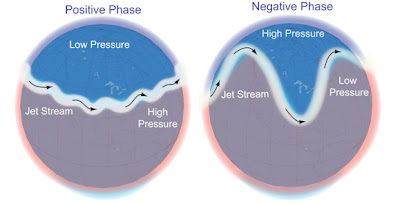In this post, I want to explain the scientific processes underlying Arctic amplification. As I discussed in my last post, changes in the Arctic may have far-reaching effects, and even exacerbate global warming. Some authors have even gone as far as identifying the region as a so-called "tipping point" (Duarte et al. 2012) - all the more reason to understand what is going on, and what we might expect.
Key to the process of Arctic Amplification is the fact that the Arctic is a sea, covered by ice, surrounded by land. Antarctica, oppositely, is a continent surrounded by ocean. The ice plays a central role in autumn, when the air starts to cool, but the water is still relatively warm. By shielding the lower parts of the atmosphere, the ice actually supports further cooling. Without the ice, the water keeps putting in heat in the atmosphere, keeping it warmer and delaying sea ice growth in winter. Any ice that does form is less extensive, and thinner, making it more susceptible to melt the following summer.
Furthermore, the ice has a much higher albedo than sea ice, meaning that it reflects more of the incoming solar radiation (and therefore, heat). It thereby reduces the heat that enters the system to begin with. Without the ice, the ocean absorbs more heat, becoming warmer, leading to warmer ocean and atmosphere in fall. Not to mention that more open patches mean that there is more interaction between ocean and atmosphere, both strengthening the feedback process I described in the paragraph above.
To visualise these processes, I drew a conceptual diagram, to give an indication of the interactions and feedback loops. It is a (very) simplified overview, in which I try to highlight some of the processes described in Serreze and Barry (2011) - any mistakes, errors and/or omissions are entirely my own. It only serves here to outline the most basic effects taking place - in reality, there are also other processes occurring that may effect sea ice extent and melt.
An overview of the most important processes in the ice-feedback systems in the Arctic. The most important effects are circled in red. Each feature has been moved to the appropriate season, except for 'Warmer Ocean' and 'More Open Water', which are of importance throughout the year (after Serreze & Barry 2011).
As can be seen in the diagram, there are some processes with multiple effects, some that may have direct and indirect effects, and some that only effect other processes in later seasons. For example, a longer summer season means more ice melts overall, but it also means that the ocean has a longer time to absorb heat (and thus absorbs more heat in total), which leads to a warmer ocean, which leads to more ice melt. A warmer ocean also means that ice formed in winter will be thinner, which makes the ice more susceptible to melt the next year.
The recent observations of Arctic warming, declining summer sea ice extent, and a reduction in multi-year ice (which is typically thicker than first-year ice) indicate that these processes are taking place in realtime, and that we should not underestimate global warming - it is taking place before our eyes.
Further Reading
- "The Melting North" - An article in The Economist from this summer, about the current melting in the Arctic and its implications
References
- Duarte, C.M., Lenton, T.M., Wadhams, P., and Wassmann, P., 2012. Abrupt climate change in the Arctic. Nature Climate Change, 2, 60-62.
- Miller, G.H., Alley, R.B., Brigham-Grette, J., Fitzpatrick, J.J., Polyak, L., Serreze, M.C., and White, J.W.C., 2010. Arctic amplification: can the past constrain the future? Quaternary Science Reviews, 29, 1779-1790.
- Screen, J.A., and Simmonds, I., 2010. The central role of diminishing sea ice in recent Arctic temperature amplification. Nature, 464, 1334-1337.
- Serreze, M.C., and Barry, R.G., 2011. Processes and impacts of Arctic amplification: A research synthesis. Global and Planetary Change, 77, 85-96.




.tiff)







